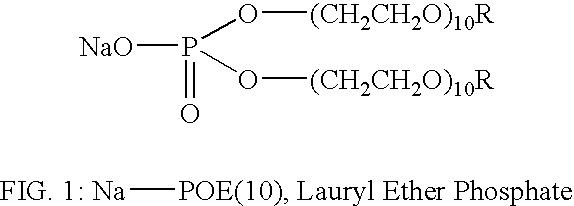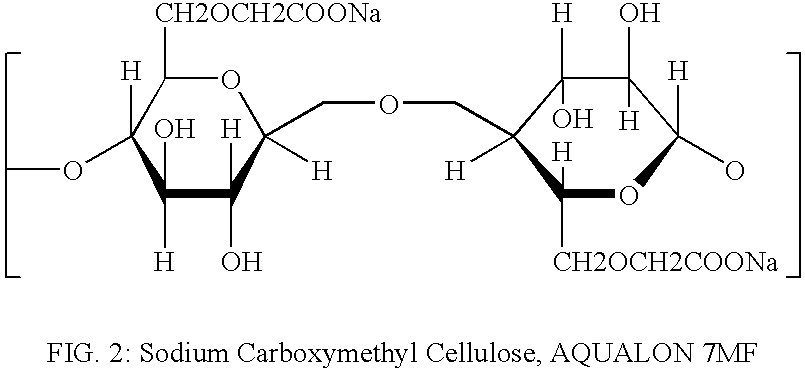Compositions and methods for preventing dental stain
- Summary
- Abstract
- Description
- Claims
- Application Information
AI Technical Summary
Benefits of technology
Problems solved by technology
Method used
Image
Examples
example 1
[0026] Na-POE(10), a Lauryl Ether Phosphate (manufactured by Nikkol Company of Japan, and distributed in the U.S. by Barnett of New Jersey), of the general structure shown in FIG. 1,
was dissolved in an aqueous solution to a concentration of 1% by weight. Hydroxyapatite (“HAP”) disks (manufactured by Clarkson Chromatography) with a diameter of 0.38″ were immersed in the above solution for 30 minutes. Before immersion, the water contact angle on the HAP disks was greater than 50 degrees. After treatment the water contact angle dropped to values below 5 degrees, and water droplets exhibited fast spreading behavior. Treated disks as well as bovine teeth treated in the same way showed no detectable staining after immersion in coffee for as long as 24 hours.
example 2
[0027] Sodium Carboxymethyl Cellulose, AQUALON 7MF (manufactured by Hercules Co.) as shown in FIG. 2,
was dissolved in an aqueous solution to a concentration of 0.50% by weight. HAP disks with a diameter of 0.38″ were immersed in the above solution for 30 minutes. Before immersion the water contact angle on the HAP disks was greater than 50 degrees. After treatment the water contact angle dropped to values below 10 degrees, and water droplets exhibited fast spreading behavior. Treated disks as well as bovine teeth treated in the same way showed no detectable staining after immersion in coffee for as long as 24 hours.
example 3
[0028] Combinations of chemical agents were shown to produce favorable synergies for stain prevention. In a series of experiments, HAP discs were first treated with saliva to generate an artificial pellicle. (The presence of a pellicle was observed to greatly increase the likelihood of staining and was applied in order to discriminate between the various treatment cycles.) Following a thorough rinse, the pellicle-treated discs were then immersed in a dilute aqueous solution containing the active compound(s) under investigation. Following a second rinse, the active-treated discs were immersed in a concentrated solution of coffee for a period of 24 hours in order to simulate a dietary stain challenge. After rinsing to remove excess coffee solution, the discs were dried and rated for stain by visual inspection. Using a subjective index of 1 to 10 (1 representing greatest stain), stain intensity is tabluated below.
Active Compound (w / w)Stain Intensity2% DLP-103.55% DLP-104.010% STP5.55...
PUM
| Property | Measurement | Unit |
|---|---|---|
| Weight | aaaaa | aaaaa |
| Water solubility | aaaaa | aaaaa |
Abstract
Description
Claims
Application Information
 Login to View More
Login to View More - R&D
- Intellectual Property
- Life Sciences
- Materials
- Tech Scout
- Unparalleled Data Quality
- Higher Quality Content
- 60% Fewer Hallucinations
Browse by: Latest US Patents, China's latest patents, Technical Efficacy Thesaurus, Application Domain, Technology Topic, Popular Technical Reports.
© 2025 PatSnap. All rights reserved.Legal|Privacy policy|Modern Slavery Act Transparency Statement|Sitemap|About US| Contact US: help@patsnap.com


